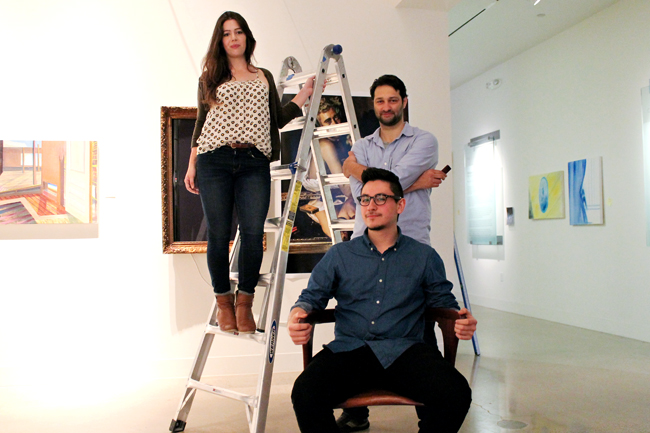There are not many events where a new video game design and a watercolor painting will be showcased in the same exhibition, but this Friday, the Visual Arts Center will be filled with sculptures, paintings, graphic designs, household designs and other contributions from UT art and design students.
The collective exhibit features the work of 50 studio art, visual art studies and art history seniors in “Wellspring,” 19 design seniors in “Make, Do, and Mend” and five design graduate students in “Playgrounds.”
Manifest Destiny
Studio art senior Regan Hann’s contribution is an installation with a taxidermy antelope wrapped
in wires.
“I always like to start with materials, so I will spend a lot of time browsing through piles of old cords and lights and things like that,” Hann said. “I usually make works that show the relationship between technology and the natural environment.”
After graduation, Hann hopes to get a job in art administration. She said this gallery exhibition provided a sense of what to expect from the professional art world come graduation in May.
“I think it’s a really great way for seniors to dip their toes into the world of having your work out there because it’s hard to get out there and make stuff happen,” Hann said. “This is my first experience with a full-fledged gallery and having my work in the show.”
Neo-Craftsmanship Chairs
Design senior Raymundo Delgadillo decided to concentrate his design degree on product design. For this exhibit, he created a line of neo-craftsman chairs out of wood and one from metal and yarn.
“I was working with curves and forms that are usually used in plastic furniture, and I was trying to transform this wood,” Delgadillo said.
While Delgadillo’s designs are not related to the 18 others through medium, the design process is what connects all of the projects.
“We were thinking about what is our methodology rather than what is our outcome, so we all agreed that we make, do and fix things — meaning mend — but also we ‘make-do’ out of what we have,” Delgadillo said. “It just depends on the context.”
Wayfinder and others
Like the undergraduate design program, the graduate design program encourages the study of different outlets of design, but the five graduate students featured tend to focus on a single project to commit most of their studies toward.
As a Type 1 diabetic, design graduate student Jesse Kinbarovsky noticed that there really weren’t tools available that would help enrich the lives of diabetics. He is focusing on creating an app and other products that allow users to work with their disease.
“For me, what that ended up becoming was a focus on diabetics and a way to incorporate that physical experience with some of the digital tools we have available to us now,” Kinbarovsky said.
Kinbarovsky said he found it frustrating that diabetics use their blood testers many times a day, yet the devices in the market are surgical and impersonal. He created the Wayfinder blood tester, which is made of wood that will mold over time to the hands of the owner. The blood tester has no display and uses different colors of light and sound to convey blood sugar levels, a method more pleasant than numbers.
“You test your blood and get a light,” Kinbarovsky said. “There is a soft glow that indicates if your blood sugar is low, correct or high. What’s interesting about the colors is that they are associated to emotions.”
All of the graduate designs work to improve the way different systems function.
“If you look at the different things in the show, we’re taking systems we think are wrong, inappropriate or not very consciously constructed. We’re taking another look at those and trying to push the system in another direction,” Kinbarovsky said.















